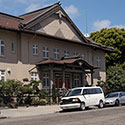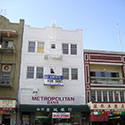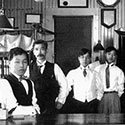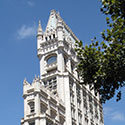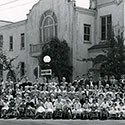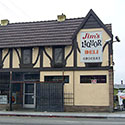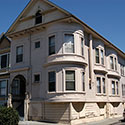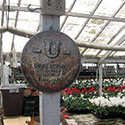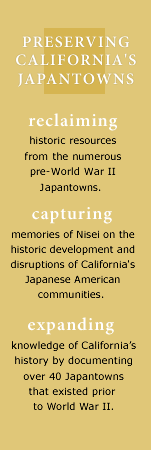 |
OaklandWith a population of almost 1,800 at the onset of WWII, Oakland’s Japanese American community was among California’s largest. Only Nihonmachi in Los Angeles, San Francisco, San Jose and Sacramento were more populous. Japanese immigrants began settling in Oakland in the 1880s and by the 1910s, had built a community of over 1,500 people. This growth was partly in response to the 1906 earthquake and fire, which pushed many refugees from San Francisco to outlying towns where they set down roots. By 1940, Oakland’s Japantown had a wide array of professional and commercial services, and an extensive list of religious, cultural, recreational and educational organizations. Although many areas of the city excluded Japanese as residents, Nikkei businesses and cultural organizations were found in a remarkably dispersed pattern from East Oakland to the Berkeley border ten miles north. While Oakland’s Nikkei community does not conform to traditional notions of a readily identifiable ethnic enclave, West Oakland and Chinatown were especially significant centers for pre-WWII Japanese American life. Of over 360 pre-WWII listings, we documented more than 140 extant structures in Oakland — the highest number of historic resources in the entire Preserving California’s Japantowns survey. These ranged from grand edifices like the Buddhist Church and elaborate downtown towers that held offices of Nikkei professionals to modest Victorian homes that held midwives and literary associations to the numerous early 20th-century commercial structures that still line many of the Oakland’s thoroughfares. ›› CLICK TO ENLARGE. PROFILES | ||||

One of a handful of California Buddhist churches still housed in their pre-war buildings, the Buddhist Church of Oakland was designed by Nisei George Shimamoto, also the architect of Buddhist churches in San Francisco and San Jose. The church started out in a rented house in 1901 and moved among sites in Oakland's Chinatown until purchasing land in 1923. The current building was dedicated in 1927 with a traditional ochigo procession, marching band and parade of dignitaries. Within a few years, a second building was erected to house classrooms, a judo hall, kitchen and meeting rooms.
In the tense period just before WWII, church members removed the manji (ancient Buddhist symbols similar to swastikas) from the church's entry and roof tiles. For the duration of their incarceration at Tanforan and Topaz Relocation Center, members stored their belongings in the building, which served as a hostel for Nikkei who returned to Oakland in 1946. Just a few years after the sangha was revived, Oakland's Buddhist Church faced the threat of eminent domain when the State of California announced plans to construct a freeway through the neighborhood in 1950. Church members deliberated over the right course of action and ultimately decided to move their church, which was cut in two and relocated three blocks north to its current location at 9th and Jackson.

Most of Oakland's historic Japanese American church structures are gone. Along with Buddhist, Konkyo, Tenrikyo and Nichiren churches, Oakland had two major Christian churches -- Sycamore Congregational and West Tenth Methodist Church, which is depicted above. Established in 1887, the Methodist congregation dedicated this sanctuary in 1918 and added a 3-story education building in 1930s. Leo Saito recalled that Methodist Minister Frank Herron mortgaged his own home so that the building could be built for the Japanese American community. During internment, more than 100 families stored their belongings inside these buildings. After the war, they served as a hostel for returning evacuees. The congregation sold the complex during the 1960s as the City of Oakland moved to assemble land for a public housing project, and in 1968 merged with the primarily Scandinavian Lake Park Methodist Church.

Chinatown is still easily located in Oakland today, but the city's significant Nikkei population and heritage are not readily evident. As we found in many or our historic resource surveys throughout California, Oakland's Chinatown was also home to many Japanese American businesses and organizations in the first decades of the twentieth century. In 1940, this structure on 8th Street housed the Kusano Hotel, offices for a Dr. Iriki and the local branch of the Japanese American News just down the block from the Yamato Company and across the street from the Shigetomi Photo Studio and Niko Niko Barber Shop and Pool Hall.

Along with cleaners and laundries, grocery stores were a mainstay of Japanese American economic life and a high percentage of the extant buildings we found. Owned by the Iino family, the chain of "Frank's Markets" appeared in several Oakland neighborhoods during the 1930s and employed many Nikkei during the years of the Great Depression. Like most Japanese Americans, who were prevented from owning property by restrictive laws, the Iinos leased their storefronts. The family lost the markets while interned, even as three of their sons served in the US military. This tudor-style building on Foothill Boulevard housed Frank's Market # 6, one of five extant structures from the family grocery chain identified through our surveys.

By 1910, West Oakland held two large Nikkei-run laundries, the Contra Costa Laundry and the Market Laundry depicted above. Market Laundry was incorporated in 1909 and thrived despite the activities of an Anti-Japanese Laundry League centered in San Francisco. The photograph above shows the Laundry's office staff along with founders K. Yabuki next to the cash register and K. Okada, second from right. Sanborn maps from 1912 note that "employees sleep on premises" and show the Myrtle Street property held a large structure for washing and ironing and a separate building that sheltered delivery vehicles. A few years earlier, the larger Contra Costa Laundry several blocks to the north offered dormitory-style lodgings for its male and female employees as well as a dining hall.

Oakland's Japanese American community was rich in social and cultural institutions including twenty-five community organizations, eleven kenjinkai or prefectural associations, and five clubhouses and halls. This building held the literary organizations Kyudo and Kohan Sha. Just a block away stood the Japanese Association, a Japanese language school, Wanto Hall and a Kendo school.

By 1942, the Japanese American community included numerous individuals with professional skills, included seventeen doctors, optometrists and dentists, as well as four midwives. A Nikkei dentist, Dr. Hayashi, had offices in the historic Cathedral Building depicted here on Broadway, and directories indicate that a Dr. Takahashi had offices in the landmark Fox Theater building. The one Nikkei druggist listed for 1940, Kashu drug at 718 Franklin, was housed in the same building as the Wakayama Kenjin Kai.

The former Hirao Nusery is the only pre-war nursery we identified in Oakland still growing flowers. In the first decades of the twentieth century, Japanese Americans had made floriculture a thriving industry around the Bay Area and by 1940 twenty-five flower growers were listed in the Oakland directory, primarily in East Oakland. The Domoto Brothers, the Issei pioneers credited with opening this niche for Japanese immigrants, established the first commercial flower-growing venture in Northern California in 1885. By 1904, their Oakland enterprise was the largest flower-growing business on the West Coast, employing numerous workers recruited from the Domoto's home prefecture of Wakayama. As Issei graduated from what was fondly termed the "Domoto College," they started their own nurseries from Richmond down the East Bay to Fremont. With little capital investment, and on small acreages of leased land, Issei could get a high return on cut flowers, which they carried daily to market at the Nikkei-run California Flower Market in San Francisco. Most of the land cultivated by families such as Hayashi, Korematsu, and Yoshida was developed as housing during the post-war period and we found only a few residences that date back to the Katayama and Nakamura nurseries that once filled many acres. The Domoto Brothers nursery was developed as Arroyo Viejo Park by the Works Project Administration in the late 1930s.
